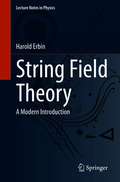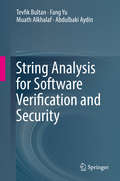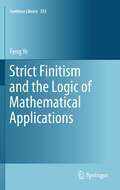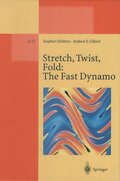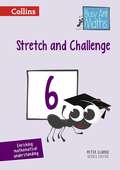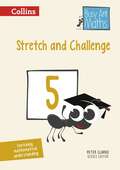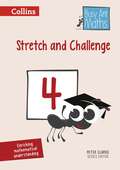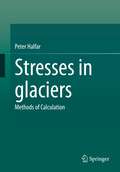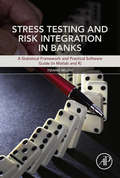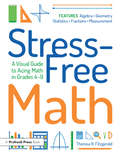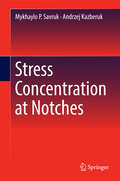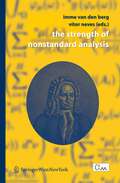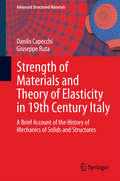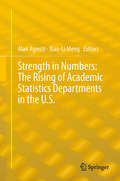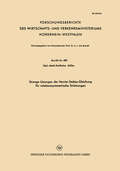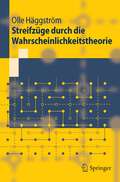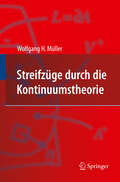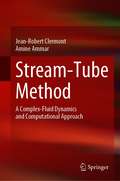- Table View
- List View
String Field Theory: A Modern Introduction (Lecture Notes in Physics #980)
by Harold ErbinThis textbook provides an introduction to string field theory (SFT). String theory is usually formulated in the worldsheet formalism, which describes a single string (first-quantization). While this approach is intuitive and could be pushed far due to the exceptional properties of two-dimensional theories, it becomes cumbersome for some questions or even fails at a more fundamental level. These motivations have led to the development of SFT, a description of string theory using the field theory formalism (second-quantization). As a field theory, SFT provides a rigorous and constructive formulation of string theory. The main focus of the book is the construction of the closed bosonic SFT. The accent is put on providing the reader with the foundations, conceptual understanding and intuition of what SFT is. After reading this book, the reader is able to study the applications from the literature. The book is organized in two parts. The first part reviews the notions of the worldsheet theory that are necessary to build SFT (worldsheet path integral, CFT and BRST quantization). The second part starts by introducing general concepts of SFT from the BRST quantization. Then, it introduces off-shell string amplitudes before providing a Feynman diagrams interpretation from which the building blocks of SFT are extracted. After constructing the closed SFT, the author outlines the proofs of several important properties such as background independence, unitarity and crossing symmetry. Finally, the generalization to the superstring is also discussed.
String Analysis for Software Verification and Security
by Tevfik Bultan Fang Yu Muath Alkhalaf Abdulbaki AydinThis book discusses automated string-analysis techniques, focusing particularly on automata-based static string analysis. It covers the following topics: automata-bases string analysis, computing pre and post-conditions of basic string operations using automata, symbolic representation of automata, forward and backward string analysis using symbolic automata representation, constraint-based string analysis, string constraint solvers, relational string analysis, vulnerability detection using string analysis, string abstractions, differential string analysis, and automated sanitization synthesis using string analysis. String manipulation is a crucial part of modern software systems; for example, it is used extensively in input validation and sanitization and in dynamic code and query generation. The goal of string-analysis techniques and this book is to determine the set of values that string expressions can take during program execution. String analysis can be used to solve many problems in modern software systems that relate to string manipulation, such as: (1) Identifying security vulnerabilities by checking if a security sensitive function can receive an input string that contains an exploit; (2) Identifying possible behaviors of a program by identifying possible values for dynamically generated code; (3) Identifying html generation errors by computing the html code generated by web applications; (4) Identifying the set of queries that are sent to back-end database by analyzing the code that generates the SQL queries; (5) Patching input validation and sanitization functions by automatically synthesizing repairs illustrated in this book. Like many other program-analysis problems, it is not possible to solve the string analysis problem precisely (i.e., it is not possible to precisely determine the set of string values that can reach a program point). However, one can compute over- or under-approximations of possible string values. If the approximations are precise enough, they can enable developers to demonstrate existence or absence of bugs in string manipulating code. String analysis has been an active research area in the last decade, resulting in a wide variety of string-analysis techniques. This book will primarily target researchers and professionals working in computer security, software verification, formal methods, software engineering and program analysis. Advanced level students or instructors teaching or studying courses in computer security, software verification or program analysis will find this book useful as a secondary text.
Strict Finitism and the Logic of Mathematical Applications (Synthese Library #355)
by Feng YeThis book intends to show that radical naturalism (or physicalism), nominalism and strict finitism account for the applications of classical mathematics in current scientific theories. The applied mathematical theories developed in the book include the basics of calculus, metric space theory, complex analysis, Lebesgue integration, Hilbert spaces, and semi-Riemann geometry (sufficient for the applications in classical quantum mechanics and general relativity). The fact that so much applied mathematics can be developed within such a weak, strictly finitistic system, is surprising in itself. It also shows that the applications of those classical theories to the finite physical world can be translated into the applications of strict finitism, which demonstrates the applicability of those classical theories without assuming the literal truth of those theories or the reality of infinity.Both professional researchers and students of philosophy of mathematics will benefit greatly from reading this book.
Stretch, Twist, Fold: The Fast Dynamo (Lecture Notes in Physics Monographs #37)
by Stephen Childress Andrew D. GilbertThe study of the magnetic fields of the Earth and Sun, as well as those of other planets, stars, and galaxies, has a long history and a rich and varied literature, including in recent years a number of review articles and books dedicated to the dynamo theories of these fields. Against this background of work, some explanation of the scope and purpose of the present monograph, and of the presentation and organization of the material, is therefore needed. Dynamo theory offers an explanation of natural magnetism as a phenomenon of magnetohydrodynamics (MHD), the dynamics governing the evolution and interaction of motions of an electrically conducting fluid and electromagnetic fields. A natural starting point for a dynamo theory assumes the fluid motion to be a given vector field, without regard for the origin of the forces which drive it. The resulting kinematic dynamo theory is, in the non-relativistic case, a linear advection-diffusion problem for the magnetic field. This kinematic theory, while far simpler than its magnetohydrodynamic counterpart, remains a formidable analytical problem since the interesting solutions lack the easiest symmetries. Much ofthe research has focused on the simplest acceptable flows and especially on cases where the smoothing effect of diffusion can be exploited. A close analog is the advection and diffusion of a scalar field by laminar flows, the diffusion being measured by an appropriate Peclet number. This work has succeeded in establishing dynamo action as an attractive candidate for astrophysical magnetism.
Stretch and Challenge 6 (Busy Ant Maths Ser.)
by Peter ClarkeChallenge and stretch Year 6 pupils with this resource designed to broaden and deepen children’s mathematical understanding. This book supports the classroom teacher in delivering structured guidance and support for gifted children who are exceeding age-related expectations in mathematics.
Stretch And Challenge 5: (PDF) (Busy Ant Maths Series)
by Peter ClarkeChallenge and stretch Year 5 pupils with this resource designed to broaden and deepen children’s mathematical understanding. This book supports the classroom teacher in delivering structured guidance and support for gifted children who are exceeding age-related expectations in mathematics. contains 36 photocopiable newspaper-style issues packed with investigations, problem-solving activities and maths challenges specific teacher guidance (and answers) in the accompanying teachers notes for all 36 issues all content is within the years programme of study evaluate children’s learning and identify the next steps for progression with detailed assessment guidance encourage children to apply their mathematical knowledge and skills across the curriculum with cross-curricular activities
Stretch And Challenge 4 (Busy Ant Maths) (PDF)
by Peter ClarkeChallenge and stretch Year 4 pupils with this resource designed to broaden and deepen children's mathematical understanding. This book supports the classroom teacher in delivering structured guidance and support for gifted children who are exceeding age-related expectations in mathematics. contains 36 photocopiable newspaper-style issues packed with investigations, problem-solving activities and maths challenges specific teacher guidance (and answers) in the accompanying teachers notes for all 36 issues all content is within the years programme of study evaluate children's learning and identify the next steps for progression with detailed assessment guidance encourage children to apply their mathematical knowledge and skills across the curriculum with cross-curricular activities
Stresses in glaciers: Methods of Calculation
by Peter HalfarIn this book, for the first time, a hitherto unknown general solution of the reliably known stress conditions is presented. This general solution forms a reliable and new starting point to get further in stress calculations than before. In this way, approximately realistic solutions can be found despite a recurring problem: the information deficits that are unavoidable due to the difficulty of exploring glaciers. This issue is demonstrated by the example of stagnating glaciers. For horizontally isotropic homogeneous tabular iceberg models, even mathematically exact unambiguous solutions of all relevant conditions are presented. All calculations use only elementary arithmetic operations, differentiations and integrations. The mathematical fundamentals are presented in detail and explained in many application examples. The integral operators specific to calculations of stresses facilitate the mathematical considerations. The stand-alone text allows the reader to understand what is involved even without considering the formulas. The author Peter Halfar is a theoretical physicist. He also developed a model of the movement of large ice caps (1983), which is still in use today.
Stress Testing and Risk Integration in Banks: A Statistical Framework and Practical Software Guide (in Matlab and R)
by Tiziano BelliniStress Testing and Risk Integration in Banks provides a comprehensive view of the risk management activity by means of the stress testing process. An introduction to multivariate time series modeling paves the way to scenario analysis in order to assess a bank resilience against adverse macroeconomic conditions. Assets and liabilities are jointly studied to highlight the key issues that a risk manager needs to face. A multi-national bank prototype is used all over the book for diving into market, credit, and operational stress testing. Interest rate, liquidity and other major risks are also studied together with the former to outline how to implement a fully integrated risk management toolkit. Examples, business cases, and exercises worked in Matlab and R facilitate readers to develop their own models and methodologies.Provides a rigorous statistical framework for modeling stress test in line with U.S. Federal Reserve FRB CCAR (Comprehensive Capital Analysis Review), U.K. PRA (Prudential Regulatory Authority), EBA (European Baning Authorithy) and comply with Basel Accord requirementsFollows an integrated bottom-up approach central in the most advanced risk modelling practiceProvides numerous sample codes in Matlab and R
Stress-Free Math: A Visual Guide to Acing Math in Grades 4-9
by Theresa R. FitzgeraldEquipped with the #1 guide to help kids (and their parents) with math homework, students will be able to quickly find the definitions and illustrated examples that will enable them to solve many of the math challenges they face. Covering everything from "addend" to "zero," Stress-Free Math:Is perfect for both kids and their parents looking for help with math homework and the tools to ace the class!Gives students in grades 4-9 more than 400 definitions, full-color illustrations, and examples.Covers subjects like measurement, algebra, geometry, fractions and decimals, statistics and probability, and problem solving.Helps students solve math problems with confidence.Is a fully updated reimagining of the best-selling Math Dictionary for Kids.This well-organized and easy-to-follow quick reference guide includes illustrated, concise explanations of the most common terms used in general math classes. Packed with strategies to help students get better grades and master math concepts without any headaches, this math study guide also discusses how students can use manipulatives and basic math tools to improve their understanding and includes handy measurement conversion tables, guides to geometric shapes, and more. Each concept covered has a concise definition and an example or illustration.Grades 4-9
Stress-Free Math: A Visual Guide to Acing Math in Grades 4-9
by Theresa R. FitzgeraldEquipped with the #1 guide to help kids (and their parents) with math homework, students will be able to quickly find the definitions and illustrated examples that will enable them to solve many of the math challenges they face. Covering everything from "addend" to "zero," Stress-Free Math:Is perfect for both kids and their parents looking for help with math homework and the tools to ace the class!Gives students in grades 4-9 more than 400 definitions, full-color illustrations, and examples.Covers subjects like measurement, algebra, geometry, fractions and decimals, statistics and probability, and problem solving.Helps students solve math problems with confidence.Is a fully updated reimagining of the best-selling Math Dictionary for Kids.This well-organized and easy-to-follow quick reference guide includes illustrated, concise explanations of the most common terms used in general math classes. Packed with strategies to help students get better grades and master math concepts without any headaches, this math study guide also discusses how students can use manipulatives and basic math tools to improve their understanding and includes handy measurement conversion tables, guides to geometric shapes, and more. Each concept covered has a concise definition and an example or illustration.Grades 4-9
Stress Concentration at Notches
by Mykhaylo P. Savruk Andrzej KazberukThis book compiles solutions of linear theory of elasticity problems for isotropic and anisotropic bodies with sharp and rounded notches. It contains an overview of established and recent achievements, and presents the authors’ original solutions in the field considered with extensive discussion. The volume demonstrates through numerous, useful examples the effectiveness of singular integral equations for obtaining exact solutions of boundary problems of the theory of elasticity for bodies with cracks and notches. Incorporating analytical and numerical solutions of the problems of stress concentrations in solid bodies with crack-like defects, this volume is ideal for scientists and PhD students dealing with the problems of theory of elasticity and fracture mechanics.
The Strength of Nonstandard Analysis
by Imme Van Den Berg Vitor NevesThis book reflects the progress made in the forty years since the appearance of Abraham Robinson’s revolutionary book Nonstandard Analysis in the foundations of mathematics and logic, number theory, statistics and probability, in ordinary, partial and stochastic differential equations and in education. The contributions are clear and essentially self-contained.
Strength of Materials and Theory of Elasticity in 19th Century Italy: A Brief Account of the History of Mechanics of Solids and Structures (Advanced Structured Materials #52)
by Danilo Capecchi Giuseppe RutaThis book examines the theoretical foundations underpinning the field of strength of materials/theory of elasticity, beginning from the origins of the modern theory of elasticity. While the focus is on the advances made within Italy during the nineteenth century, these achievements are framed within the overall European context. The vital contributions of Italian mathematicians, mathematical physicists and engineers in respect of the theory of elasticity, continuum mechanics, structural mechanics, the principle of least work and graphical methods in engineering are carefully explained and discussed. The book represents a work of historical research that primarily comprises original contributions and summaries of work published in journals. It is directed at those graduates in engineering, but also in architecture, who wish to achieve a more global and critical view of the discipline and will also be invaluable for all scholars of the history of mechanics.
Strength in Numbers: The Rising of Academic Statistics Departments in the U. S.
by Alan Agresti and Xiao-Li MengStatistical science as organized in formal academic departments is relatively new. With a few exceptions, most Statistics and Biostatistics departments have been created within the past 60 years. This book consists of a set of memoirs, one for each department in the U.S. created by the mid-1960s. The memoirs describe key aspects of the department’s history -- its founding, its growth, key people in its development, success stories (such as major research accomplishments) and the occasional failure story, PhD graduates who have had a significant impact, its impact on statistical education, and a summary of where the department stands today and its vision for the future. Read here all about how departments such as at Berkeley, Chicago, Harvard, and Stanford started and how they got to where they are today. The book should also be of interests to scholars in the field of disciplinary history.
Strenge Lösungen der Navier-Stokes-Gleichung für rotationssymmetrische Strömungen (Forschungsberichte des Wirtschafts- und Verkehrsministeriums Nordrhein-Westfalen #489)
by Karlheinz MüllerStreifzüge durch die Wahrscheinlichkeitstheorie (Springer-Lehrbuch)
by Olle HäggströmDies ist eine Einführung in die Wahrscheinlichkeitstheorie - der Mathematik des Zufalls. In einer mehr oder weniger losen Folge von Kapiteln werden veschiedene Themen angesprochen: Ein Teil behandelt klassische Begriffe, wie Irrfahrten oder die Gesetze der großen Zahlen, während andere Kapitel zeigen, wie die Mathematik in aktuelle Forschungen, z.B. die der Evolutionsbiologie, eingreift. Anschaulich wird der Zusammenhang zur Spieltheorie erläutert. Der Text widmet sich ausführlich einigen der am meisten diskutierten Paradoxa der Wahrscheinlichkeitstheorie, deren Betrachtung zu lehrreichen Einsichten führt. Einen wichtigen Raum nimmt auch die Perkolation und ihre Anwendungen ein, so wird zum Beispiel das so genannte "kleine Welt"-Phänomen mathematisch untersucht. Das Buch ist in erster Linie als Zusatzlektüre für Vorlesungen zur Stochastik und mathematischen Statistik im Grundstudium an Universität und Hochschule gedacht. Darüber hinaus gibt es Anregungen für Gymnasiallehrer und ihre Schüler. Häggströms Buch leistet für die Wahrscheinlichkeitstheorie das, was Jänichs für die Topologie tut.
Streifzüge durch die Kontinuumstheorie
by Wolfgang H. MüllerDas Buch führt in die Bereiche der Kontinuumstheorie ein, die für Ingenieure relevant sind: die Deformation des elastischen und des plastifizierenden Festkörpers, die Strömung reibungsfreier und reibungsbehafteter Fluide sowie die Elektrodynamik. Der Autor baut die Theorie im Sinne der rationalen Mechanik auf, d. h., er erstellt ein Feldgleichungssystem und gibt – sozusagen nebenbei – eine Einführung in die Tensoranalysis. Dabei werden sowohl der Indexkalkül als auch die absolute Schreibweise verwendet und gegenübergestellt.
Stream-Tube Method: A Complex-Fluid Dynamics and Computational Approach
by Jean-Robert Clermont Amine AmmarThis book presents the stream-tube method (STM), a method offering computational means of dealing with the two- and three-dimensional properties of numerous incompressible materials in static and dynamic conditions. The authors show that the kinematics and stresses associated with the flow and deformation in such materials can be treated by breaking the system down into simple computational sub-domains in which streamlines are straight and parallel and using one or two mapping functions in steady-state and non-steady-state conditions.The STM is considered for various problems in non-Newtonian fluid mechanics with different geometries. The book makes use of examples and applications to illustrate the use of the STM. It explores the possibilities of computation on simple mapped rectangular domains and three-dimensional parallel-piped domains under different conditions. Complex materials with memory are considered simply without particle tracking problems.Readers, including researchers, engineers and graduate students, with a foundational knowledge of calculus, linear algebra, differential equations and fluid mechanics will benefit most greatly from this book.
Straw Man Arguments: A Study in Fallacy Theory
by Scott Aikin John CaseyThis book analyses the straw man fallacy and its deployment in philosophical reasoning. While commonly invoked in both academic dialogue and public discourse, it has not until now received the attention it deserves as a rhetorical device. Scott Aikin and John Casey propose that straw manning essentially consists in expressing distorted representations of one's critical interlocutor. To this end, the straw man comprises three dialectical forms, and not only the one that is usually suggested: the straw man, the weak man and the hollow man. Moreover, they demonstrate that straw manning is unique among fallacies as it has no particular logical form in itself, because it is an instance of inappropriate meta-argument, or argument about arguments. They discuss the importance of the onlooking audience to the successful deployment of the straw man, reasoning that the existence of an audience complicates the dialectical boundaries of argument. Providing a lively, provocative and thorough analysis of the straw man fallacy, this book will appeal to postgraduates and researchers alike, working in a range of fields including fallacies, rhetoric, argumentation theory and informal logic.
Straw Man Arguments: A Study in Fallacy Theory
by Scott Aikin John CaseyThis book analyses the straw man fallacy and its deployment in philosophical reasoning. While commonly invoked in both academic dialogue and public discourse, it has not until now received the attention it deserves as a rhetorical device. Scott Aikin and John Casey propose that straw manning essentially consists in expressing distorted representations of one's critical interlocutor. To this end, the straw man comprises three dialectical forms, and not only the one that is usually suggested: the straw man, the weak man and the hollow man. Moreover, they demonstrate that straw manning is unique among fallacies as it has no particular logical form in itself, because it is an instance of inappropriate meta-argument, or argument about arguments. They discuss the importance of the onlooking audience to the successful deployment of the straw man, reasoning that the existence of an audience complicates the dialectical boundaries of argument. Providing a lively, provocative and thorough analysis of the straw man fallacy, this book will appeal to postgraduates and researchers alike, working in a range of fields including fallacies, rhetoric, argumentation theory and informal logic.
Stratified Morse Theory (Ergebnisse der Mathematik und ihrer Grenzgebiete. 3. Folge / A Series of Modern Surveys in Mathematics #14)
by Mark Goresky Robert MacPhersonDue to the lack of proper bibliographical sources stratification theory seems to be a "mysterious" subject in contemporary mathematics. This book contains a complete and elementary survey - including an extended bibliography - on stratification theory, including its historical development. Some further important topics in the book are: Morse theory, singularities, transversality theory, complex analytic varieties, Lefschetz theorems, connectivity theorems, intersection homology, complements of affine subspaces and combinatorics. The book is designed for all interested students or professionals in this area.
Stratified Mappings - Structure and Triangulability (Lecture Notes in Mathematics #1102)
by A. VeronaStratified Lie Groups and Potential Theory for Their Sub-Laplacians (Springer Monographs in Mathematics)
by Andrea Bonfiglioli Ermanno Lanconelli Francesco UguzzoniThis book provides an extensive treatment of Potential Theory for sub-Laplacians on stratified Lie groups. It also provides a largely self-contained presentation of stratified Lie groups, and of their Lie algebra of left-invariant vector fields. The presentation is accessible to graduate students and requires no specialized knowledge in algebra or differential geometry.
